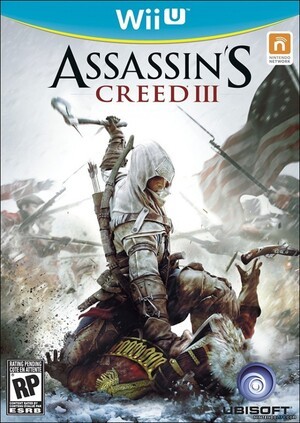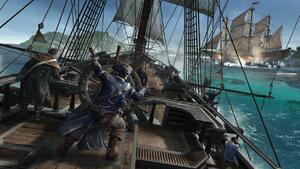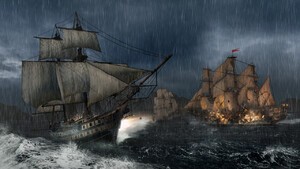
Assassin’s Creed III is one of Wii U’s highest-profile launch titles, with the November date coming just a few weeks after its appearance on the other HD systems. It’s also one of Ubisoft’s most ambitious development projects in its long history, with a number of studios and hundreds of staff working on what it hopes will be a leap forward for the franchise.
While much has been done to refresh the series, not least a relocation to the American Revolutionary War in 1775 and environments significantly different from Mediterranean Europe, Ubisoft has added an entirely new style of gameplay. When you’re not sneaking around colonial cities, roof jumping or hunting the enemy in winter forests, you’ll be out at sea and engaging in naval missions. At a hands-on event at Nintendo Europe’s HQ in Frankfurt, this was the scenario given to us in a demo; it immediately stood out as one of the most engaging experiences on show.
Subscribe to Nintendo Life on YouTube841k
One of the first things to strike us, which is peculiar after years of being forced to side-line graphical concerns with Wii, is just how visually arresting this title is. The development team has suggested that Wii U will lack a few specific graphical effects included in the Xbox 360 and PS3 versions, by virtue of having less time to work with the hardware, but the overall impression was overwhelmingly positive. At the start of the mission you’re sailing under clear skies with land areas rich with vegetation, yet within ten minutes you’re involved in a tense battle amidst a dramatic storm. The visual impact and physics of the waves contribute to the overall sense of tension, which scores a point for the graphics and processor advocates out there.
The sequence available had barely 10 seconds of standard Assassin’s Creed play, as we were instructed to walk the character towards the ship’s wheel; there were no sneaky kills or daring jumps. Once you’re in control of the ship it’s immediately clear that the developers took the principles of maritime craft in this period, and duly injected them with steroids and doubled the speed. As you steer with the left stick of the GamePad you have a sensation of moving a sizable and weighty ship, but there’s still a meaningful tempo to the craft’s movements. Those looking for any kind of historical realism should know better than to expect it in this series, but it’s a warning worth giving to those who envisioned a detailed simulation of 18th Century naval warfare.

That aside, it has an authentic feeling from a video game perspective, as you can’t drag the ship around like a speedboat but need to make planned and deliberate moves. Raising and lowering sails determines speed with the press of a button, while the right stick is used for camera control. It’s simple, yet we endured a poor start in the basic task of chasing down another ship. Despite following it directly we started to fall further behind, until we realised that we weren’t sailing in the optimal direction to make use of the wind, an early lesson that a simple exterior was hiding some clever mechanics.
Before long it all changed, and we were pounced upon by two additional ships and involved in a battle. It was only natural that this would prompt dramatic music and the gathering of the aforementioned storm clouds, and the whole experience took a turn for the cinematic. The battle that followed gave a good mixture of action and strategy, with the ZL (rear) left shoulder button used to aim and fire a single shot cannon, and the ZR right shoulder button limited to side-by-side exchanges of the bulk cannons. With waves crashing, a crew working feverishly and signs of damage on the ship, it’s all intense and instinctive to play.
Still, it’s a sign of this title’s multi-platform status, and a minimal engagement with Wii U’s unique selling points, that we didn’t look at the GamePad screen until the battle was in full flow. It provided a useful map, ideal for tracking enemy movements, and it was also used at one point to switch cannon type by tapping an icon when R was held down. We expect to see a lot of this limited use of the extra screen in multi-platform games – in fact, we already have – so it was little surprise. That change in cannon type did at least show us a new facet of the naval battles, as our purpose changed from sinking a ship to disabling it. Cue a cut-scene of men getting ready to board the other ship, though sadly but predictably our demo then stopped us short.

Ubisoft clearly wanted to show off its new feature in Assassin’s Creed III, alongside its very public promises that the standard series gameplay will also show improvements in physics and animations, to name two areas. In the parts we’ve played it seems to have found the right balance, producing what could really be described as video game realism: we know naval battles probably weren’t like this in reality, but it’s how we like to imagine them. It was well-crafted, exciting and easy to play.
So, are there any caveats? For one it’ll be interesting to see how these scenarios vary in the final product to avoid excessive repetition. It’s also, unsurprisingly, a launch title that makes minimal use of the GamePad controller, providing a map and a tap to change weapons. We suspect land-based play will employ the extra screen for similar uses, so this won’t be a title to show off what makes Wii U different and unique from its competitors. Based on this impression of a small section, however, it could be one of the most accomplished third-party releases on the system, if not the most innovative.
Comments 13
cant wait to see a diferences list for cross-platform variations.
i suspect the WiiU to have it run with better fps, but lacking some visual effects
looks awesome. I hope they make a version for the 3DS, but I doubt it
This title is really convincing me into the series. Plus, I'm studying the revolutionary war right now
This is a definite must buy for me!
Can I have it please?
Boy, when you guys say - in the very near future - you aren't kidding around.
This is the only title I'm really looking forward to on any system this holiday, glad you enjoyed your time with it. (I'm not holding my breath for Pikmin 3 BEFORE the holiday.)
My brother is already getting it for the Xbox360, but if not, I´ll definitely buy it on the Wii U.
It looks pretty cool , I might get later on...
I'm planning to get both a Wii U and Assassin's Creed III, though I don't know if I'll wait for the Wii U version of the game. After all, who knows when I'll be getting the Wii U, since preordering from where I live it's not precisely easy, specially with it being either sold out or overpriced (Amazon has the Deluxe pack at 600 dollars and the regular at almost 500! WTF?!?).
what im wondering is will it have any DLC like the other versions? or will those come later or maybe a pre order bonus =|
I'm a big fan of this series. While I've always bought the previous games on the PS3, I'll probably get this one on Wii U just to support the third-party developers who actually put forth the effort to support Nintendo's systems.
really want to get this game because it looks cool but i have three young kids so that's why i might not get it.
I'm super happy Nintendo is getting better third part support. However, I think I'll stick to playing this on my PC and save my Wii U money for exclusives!
Show Comments
Leave A Comment
Hold on there, you need to login to post a comment...